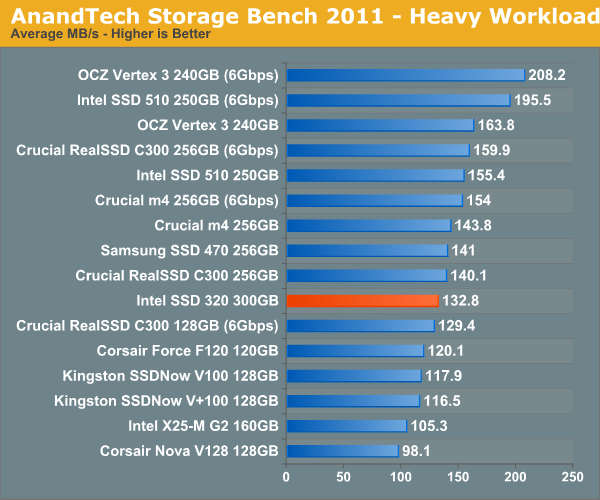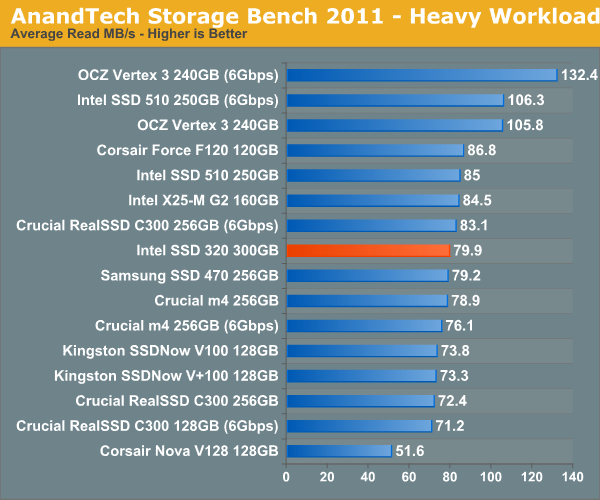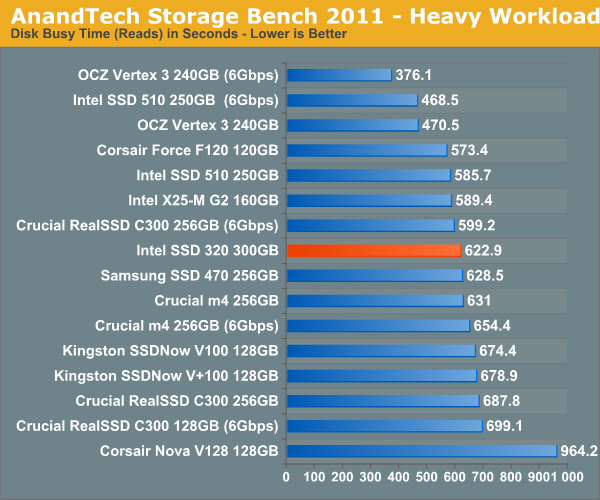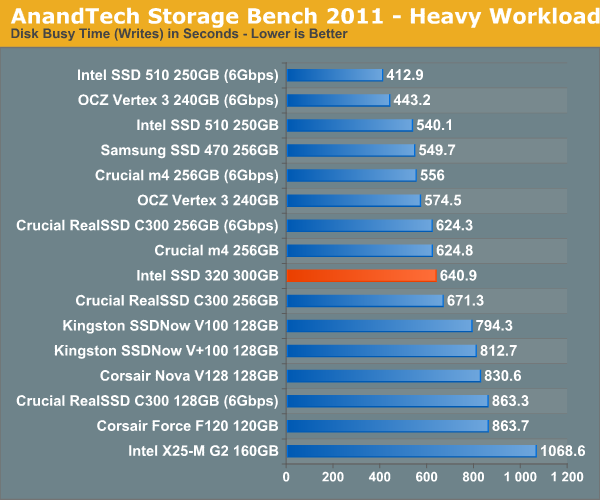The Intel SSD 320 Review: 25nm G3 is Finally Here
by Anand Lal Shimpi on March 28, 2011 11:08 AM EST- Posted in
- IT Computing
- Storage
- SSDs
- Intel
- Intel SSD 320
AnandTech Storage Bench 2011: Much Heavier
I didn't expect to have to debut this so soon, but I've been working on updated benchmarks for 2011. Last year we introduced our AnandTech Storage Bench, a suite of benchmarks that took traces of real OS/application usage and played them back in a repeatable manner. I assembled the traces myself out of frustration with the majority of what we have today in terms of SSD benchmarks.
Although the AnandTech Storage Bench tests did a good job of characterizing SSD performance, they weren't stressful enough. All of the tests performed less than 10GB of reads/writes and typically involved only 4GB of writes specifically. That's not even enough exceed the spare area on most SSDs. Most canned SSD benchmarks don't even come close to writing a single gigabyte of data, but that doesn't mean that simply writing 4GB is acceptable.
Originally I kept the benchmarks short enough that they wouldn't be a burden to run (~30 minutes) but long enough that they were representative of what a power user might do with their system.
Not too long ago I tweeted that I had created what I referred to as the Mother of All SSD Benchmarks (MOASB). Rather than only writing 4GB of data to the drive, this benchmark writes 106.32GB. It's the load you'd put on a drive after nearly two weeks of constant usage. And it takes a *long* time to run.
I'll be sharing the full details of the benchmark in some upcoming SSD articles but here are some details:
1) The MOASB, officially called AnandTech Storage Bench 2011 - Heavy Workload, mainly focuses on the times when your I/O activity is the highest. There is a lot of downloading and application installing that happens during the course of this test. My thinking was that it's during application installs, file copies, downloading and multitasking with all of this that you can really notice performance differences between drives.
2) I tried to cover as many bases as possible with the software I incorporated into this test. There's a lot of photo editing in Photoshop, HTML editing in Dreamweaver, web browsing, game playing/level loading (Starcraft II & WoW are both a part of the test) as well as general use stuff (application installing, virus scanning). I included a large amount of email downloading, document creation and editing as well. To top it all off I even use Visual Studio 2008 to build Chromium during the test.
Many of you have asked for a better way to really characterize performance. Simply looking at IOPS doesn't really say much. As a result I'm going to be presenting Storage Bench 2011 data in a slightly different way. We'll have performance represented as Average MB/s, with higher numbers being better. At the same time I'll be reporting how long the SSD was busy while running this test. These disk busy graphs will show you exactly how much time was shaved off by using a faster drive vs. a slower one during the course of this test. Finally, I will also break out performance into reads, writes and combined. The reason I do this is to help balance out the fact that this test is unusually write intensive, which can often hide the benefits of a drive with good read performance.
There's also a new light workload for 2011. This is a far more reasonable, typical every day use case benchmark. Lots of web browsing, photo editing (but with a greater focus on photo consumption), video playback as well as some application installs and gaming. This test isn't nearly as write intensive as the MOASB but it's still multiple times more write intensive than what we were running last year.
As always I don't believe that these two benchmarks alone are enough to characterize the performance of a drive, but hopefully along with the rest of our tests they will help provide a better idea.
The testbed for Storage Bench 2011 has changed as well. We're now using a Sandy Bridge platform with full 6Gbps support for these tests. All of the older tests are still run on our X58 platform.
AnandTech Storage Bench 2011 - Heavy Workload
We'll start out by looking at average data rate throughout our new heavy workload test:

Overall performance is decidedly last generation. The 320 is within striking distance of the 510 but is slower overall in our heavy workload test.
The breakdown of reads vs. writes tells us more of what's going on:


The next three charts just represent the same data, but in a different manner. Instead of looking at average data rate, we're looking at how long the disk was busy for during this entire test. Note that disk busy time excludes any and all idles, this is just how long the SSD was busy doing something:













194 Comments
View All Comments
B3an - Monday, March 28, 2011 - link
lol @ this SSD.But most of all lol @ the price for this performance.
wumpus - Tuesday, March 29, 2011 - link
Somehow they sell chips that perform at levels AMD meets, as well as the high end. Both get large intel mark ups. Lol at the customers.Cow86 - Monday, March 28, 2011 - link
Have to agree here, I was looking forward to this drive to be decent performance at a low price....Performance is a bit less than I hoped for though, and the pricing is actually the same or higher than last gen. I'm looking to purchase an SSD in a few months (based on bulldozer, so somewhere late june probably) for a full rebuild of my pc, and I'll look at the pricing landscape then, but so far am dissapointed at the pricing of this entire new generation....wasn't 25 nm supposed to lower prices?As a sidenote, I couldn't help but take note of Crucial M4 results in the graphs here (which frankly, whilst doing great in write performance, seem a bit of a letdown in read performance compared to the C300?). Have I missed a review of that here, or is that inbound and have the results simply already been included in this review?
semo - Monday, March 28, 2011 - link
25nm nodes are more prone to errors and have a lower lifespan. This, and possibly other limitation, have necessitated workarounds that eat in to the savings due to smaller size (more reserve space, more ECC).Japan's natural disasters have also impacted global supply of flash (which hasn't been able to meet demand for a while now anyway)
ArteTetra - Monday, March 28, 2011 - link
I don't think this chips come from Japan. I think they are made in Lehi, Utah, USA.Furthermore, look at the date on those chips. It says 2008 and 2009, not 2011.
vol7ron - Monday, March 28, 2011 - link
I think Intel was using Samsung memory though. I'm not sure if these are manufactured in South Korea, or if Samsung has a plant in Japan.Griswold - Tuesday, March 29, 2011 - link
No. Do you pull that crap out of your ass before posting it?dagamer34 - Monday, March 28, 2011 - link
Sure, 25nm was supposed to lower prices, but all it demonstrates was that Intel was charging more for its drive previously anyway.Just looking at benchmarks, the OCZ Vertex 3 is gonna be the drive to beat, though it still isn't shipping to any retailers for sale yet.
Gami - Monday, March 28, 2011 - link
there's nothing to beat, if you're not ont he market for sale.Anand Lal Shimpi - Monday, March 28, 2011 - link
The m4 arrived while I was at CTIA last week so I just had enough time to run it through our suite. A full review of it and much more is coming soon :)